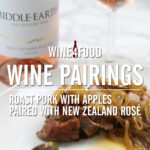An Introduction to New Zealand’s Wines
Since exploding onto the scene with its distinctively delicious Sauvignon Blanc, New Zealand’s winemakers continue to keep things fresh and exciting vintage after vintage. New Zealand has claimed its rightful place on the map, but it is still one of the relative newcomers to the wine world. While James Busby brought vines over from Europe and planted them around the country during the 19th century, it wasn’t until the 1970s and ’80s that Kiwi winemakers began to ply their trade, and with breathtaking results. Today, Sauvignon Blanc remains the cornerstone of New Zealand’s wine industry. That said, local winemakers are demonstrating that there’s plenty more to discover beyond the wine that helped them become a force in the wine world.
Get to Know the Grapes
Kiwi winemakers made a name for themselves with Sauvignon Blanc back in 1979. To this day, the Sauvignon Blancs of New Zealand still make up the majority of vineyard plantings. They represent the bulk of wine production at a whopping seventy-five percent. But there’s a whole other world beyond Sauvignon Blanc to discover in the Land of the Long White Cloud. Thanks to its largely maritime climate and generally cooler temperatures, grapes which excel in cooler climates, such as Chardonnay, Riesling, Pinot Gris, and Gewürztraminer, have found a flourishing home in New Zealand. The complex patchwork of soils and micro-terroirs across New Zealand has allowed winemakers to plant their vineyards with grapes best suited for each site. This is one of the reasons why its Sauvignon Blancs are laden with aromas of passion fruit and gooseberry. The cool climate brings out the pyrazines; compounds found in Sauvignon Blanc which cause grassy, herbaceous aromas and flavors in the wine. It’s one of the hallmarks of New Zealand’s most famous grape.

While many might think of New Zealand as a predominately white wine producing country (which is a fair assessment), some of its most exhilarating wines are actually its reds. Pinot Noir performs beautifully in many of the wine regions on the South Island; from Martinborough down to Central Otago. Full of finesse yet brimming with incredible fruit flavor, New Zealand Pinot Noir lies in the sweet spot for folks who lean towards the Old World elegance of Burgundy but desire a more fruit-driven character.
It’s not just thin-skinned, cool climate grapes that thrive in the world’s most southerly wine-making country. Back on the North Island, luscious Bordeaux-style blends and aromatic yet stylish Syrahs represent the next wave of New Zealand winemaking. Merlot tends to dominate red blends, providing lush, ripe berry flavors to the power of Cabernet Sauvignon and spicy, herbal Cabernet Franc.
A Look At New Zealand’s Wine Regions
Embraced on either side by the Tasman Sea in the east and the South Pacific Ocean to the west, New Zealand’s climate is largely maritime. Thanks to the topography of the islands and the presence of the Southern Alps, vineyards are present everywhere from valley floors to hillsides that are several hundred meters above sea level. Because so many of New Zealand’s wine regions receive hours of sun while being protected from bad weather, organic and sustainable viticulture becomes a more viable option here. Although at present only six percent of New Zealand’s vineyards are certified organic, this number is steadily growing. For anyone interested in drinking these so-called “green wines,” New Zealand is a fantastic place to begin your exploration of sustainably-made wines.
Hawke’s Bay

Hawke’s Bay, located on the east coast of the North Island, is New Zealand’s oldest wine region and its second largest in terms of production. Protected from wind and rain, Hawke’s Bay is warm and sunny. This is one of the reasons winemakers have been so successful at growing Merlot and Cabernet Sauvignon for their highly acclaimed Bordeaux-style blends, peppery Syrahs, and fruity, complex Chardonnays. Well-draining soils, such as those found in the Gimblett Gravels subregion, recall the stony soils of Bordeaux’s Left Bank, allowing vines to dig deep into the earth. Alluvial deposits from Hawke’s Bay’s many rivers mean excellent soil diversity across its various subregions; gravel, clay, sand, and loam mean winemakers can further customize which sites to plant with which specific grapes.
The Cabernet-Merlot blends of Hawke’s Bay are ideal for steaks and roast beef. Lamb chops with mint sauce wouldn’t be out of place here either. You can swap out the Bordeaux style in favor of a Syrah if you’re serving up your ribeye with a side of peppercorn sauce.
Gisborne
Just north of Hawke’s Bay, Gisborne’s vineyards are the first to see the light of each new day. The lion’s share of Gisborne’s viticulture is dedicated to white wine. Chardonnay is the star here, but spicy Gewürztraminer and heady Pinot Gris, Riesling, Chenin Blanc, and Viognier also call Gisborne home as well. Any of these richer, aromatic white wines make fantastic pairings for cheese plates or creamy pasta sauces, but the Viognier, in particular, is wonderful with roast chicken or duck. A slightly off-dry Riesling is an ideal pairing for the fruity meringue confection known as the Pavlova, a New Zealand dessert created in honor of the famous Russian ballerina Anna Pavlova.
Historically Gisborne produced bulk and fortified wines, but winemakers are moving towards higher quality over quantity with a growing number of boutique wineries being established in the region. With a combination of plentiful sunshine and moderating ocean breezes, grapes are able to ripen to perfection in Gisborne while still holding onto the acidity that’s needed for well-balanced wines.
Wairarapa

Wairarapa lies just across the Cook Strait from Marlborough at the North Island’s southernmost point. Many styles are made here including Pinot Noir, Syrah, and Sauvignon Blanc. Because it’s slightly warmer here, the wines are richly flavored with powerful aromas and captivating palates. A long growing season with warm summers tempered by cool winds means that making dessert wines becomes an option in Wairarapa. This is due to the fact that grape bunches are allowed to hang on the vine beyond the typical harvest time for dry wines. The longer they remain, the more sugars they develop and the riper they become. To this end, aromatic grape varieties like Pinot Gris, Riesling, Gewürztraminer, and Viognier have earned vineyard space and become noteworthy additions to Wairarapa’s winemaking scene.
Nelson

New Zealand’s sunniest region is girdled on three sides by mountains and opens onto Tasman Bay. Bay breezes cool the vineyards at night which help sunny Nelson’s wines to achieve perfect harmony. They strike the balance between intense varietal flavor and mouthwatering acidity. You’ll find a variety of wines made here. There’s the expressive, slightly herbal Sauvignon Blanc, a brilliant match for baked salmon with dill and lemon. Or the pure appley Chardonnay which has just the right balance between body and crisp acidity, outstanding with everything from Kiwi favorite fish and chips, to lighter pasta dishes. Then of course, we have Nelson’s generous, palate-coating, full-bodied Pinot Noir. But winemakers are also experimenting with the likes of Riesling, perfumed Pinot Gris, and Gewürztraminer as well. Similar to Wairarapa, you’ll encounter both dry and sweet late harvest styles made in the two subregions of Nelson: Moutere Hills and Waimea Plains.
Marlborough

It’s the superstar of all New Zealand winemaking regions. This is where it all started. Marlborough’s racy, flavourful Sauvignon Blanc helped catapult the country to worldwide acclaim and quickly established New Zealand as a contender on the world wine stage. There’s a patchwork of terroirs in Marlborough, enough to warrant three distinct subregions: Awatere Valley, Wairau Valley, and Southern Valley. It’s cool yet sunny here which leads to wines that are high in acid but with a ripe, fruity profile. Grassy, tropical Sauvignon Blanc reigns king in Marlborough, but there are increasing plantings of Pinot Noir, Chardonnay, and the same cool-loving aromatic grape varieties we see in other parts of the islands. Because of the purity of fruit, high acid and finesse found in Marlborough’s wines, they make great accompaniments to a variety of dishes. Marlborough Sauvignon Blanc is phenomenal with aromatic Asian-inspired seafood and shellfish dishes with lemongrass, citrus, or garlic. The grape’s inherent herbaceous qualities make it a winner with herb-laden dishes and salads as well. And for anyone who loves oysters, Marlborough Chardonnay or sparkling wines based on Chardonnay are a must. The clean, bright green apple profile of these wines goes beautifully with freshly shucked oysters.
Like the pioneers that they are, a handful of Marlborough’s winemakers are dabbling in less common grapes like Grüner Veltliner, Spanish Tempranillo and Albarino, and Italian varietals like Arneis and Barbera. So far, the results are exciting (and delicious!) with many of these wines picking up awards and recognition by wine critics and wine lovers alike.
Central Otago

The world’s most southerly wine region is Pinot Noir country. The Southern Alps are the defining feature of the region. Not only do they offer protection from cool storm systems off the Tasman Sea, they also make Central Otago New Zealand’s highest elevation region. Whereas much of New Zealand has a maritime climate, Central Otago is more continental and many vineyards sit on hillsides where they can soak up ample sun, allowing the grapes to get perfectly ripe. Central Otago’s Pinot Noirs tend towards being riper and fuller bodied in style with cherries, berries, earth, and violet notes. This makes them perfect for duck, turkey (especially with cranberry sauce), or game birds like quail or pheasant. These wines are also spectacular with lamb and grilled pork, or the traditional Maori hāngi, which features a variety of meat and vegetables cooked in a pit oven. Although Pinot Noir represents the bulk of Central Otago’s winemaking, you’ll also find lovely white wines made from Pinot Gris, Riesling, Gewürztraminer, and Chardonnay. This is also a fantastic spot to look if you’re on the hunt for lively rosés to enjoy year round.
A few decades into being a major player in the wine world, New Zealand shows no signs of slowing down. As winemakers continue to innovate, experiment, and produce outstanding wines, there’s no doubt in our minds that New Zealand will remain a favorite with wine lovers and win over new fans in the years to come.
Ready for recommendations? Get acquainted with New Zealand through these excellent wines.

Hawke’s Bay:
Craggy Range Te Kahu – A Bordeaux blend with black cherry, blackcurrant, plum, and sweet baking spice notes that is perfect for drinking now but can also age well for a few years. $23
Esk Valley Chardonnay – Ripe Meyer lemon, melon, and white peach with sweet baking spice, and a touch of butter. $15
Gisborne:
Bushmere Estate Chardonnay – A ripe Chardonnay with ample stone fruit, citrus, and round body thanks to French oak barrel fermentation. $23
Matawhero Single Vineyard Gewürztraminer – A classic, full-bodied Gewürztraminer full of ginger, spice, lychee, and rose petals. $23
Wairarapa:
Schubert Syrah – Intense berries and spice, with a pleasant earthiness and a hint of smoke. Complex and full of flavor. $50
Matahiwi Holly Late Harvest – A gorgeous blend of Sauvignon Blanc and Riesling, this wine is full of honeyed notes, lemon curd, and spice. $20
Nelson:
Greenhough Hope Vineyard Riesling – This single vineyard organic Riesling has citrus, peach, and slightly savory mineral notes rounded out by a generous texture. $22
Middle-Earth Chardonnay*– A ripe Chardonnay to rule them all, with tropical pineapple, peach, and a touch of creaminess. $24
Middle-Earth Albarino*– Floral aromas meet zesty citrus, ripe peach, and a touch of salinity in this wonderfully mineral Albarino. $24
*Inquire with one of these retailers
Marlborough:
Brancott Estate Sauvignon Blanc– Classic gooseberry, bright citrus, and peach with lively acidity. $13
Spy Valley Sauvignon Blanc – This tropical Sauvignon Blanc leads with passion fruit, melon, and citrus with the suggestion of bell pepper. $12
Central Otago:
Two Paddocks Pinot Noir – Gorgeous ripe red berries and cherries, with a hint of floral aromas, and plenty of spice, finishing with a touch of minerality. $44
Felton Road Pinot Noir Bannockburn – Spicy and floral with satisfying berry notes. $40
Rockburn Tigermoth Riesling – An off-dry Riesling featuring ripe stone fruit, lime, and satsuma, balanced out with racy acidity. $33
Peregrine Rose – Strawberries and cream, cherry, and beautiful red berry flavors. $19




